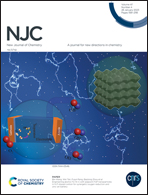FAPbBr3 perovskite nanocrystals decorated on a graphitic carbon nitride (g-C3N4) sheet for interfacial hole transfer†
Abstract
Hydrophobically capped formamidinium lead bromide (FAPbBr3) perovskite nanocrystals (PNCs) exhibit bright green emission in the solution state. Photoluminescence (PL) spectral studies and time-correlated single photon counting (TCSPC) measurements were performed to evaluate the interfacial hole transfer phenomenon. Both the absolute photoluminescence quantum yield (PLQY) and the decay lifetime value decrease with graphitic carbon nitride (g-C3N4), which is attributed to the migration of holes from the ground state of the PNCs to g-C3N4. The quenching of emission is accompanied by a change in the lifetime value indicating the static nature of quenching. Moreover, the PL quenching phenomenon was also analyzed via electrochemical studies. The decoration of FAPbBr3 perovskite NCs on a g-C3N4 sheet was analyzed via TEM images obtained. The change in the oxidation state of nanocomposites such as FAPbBr3@g-C3N4 compared with pristine-FAPbBr3 provided evidence of the modified chemical environment of FAPbBr3.



 Please wait while we load your content...
Please wait while we load your content...